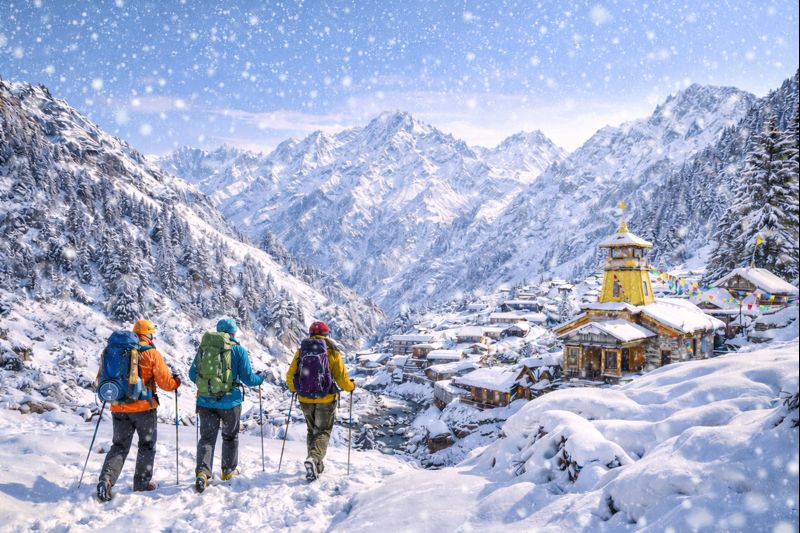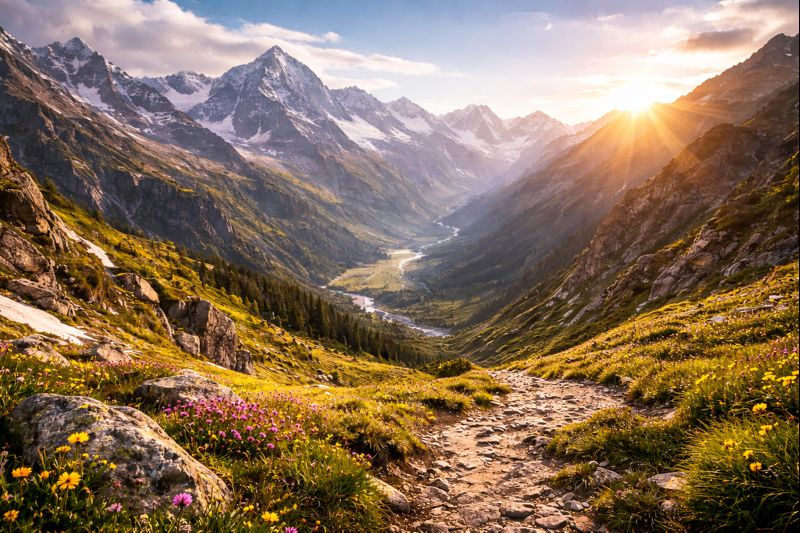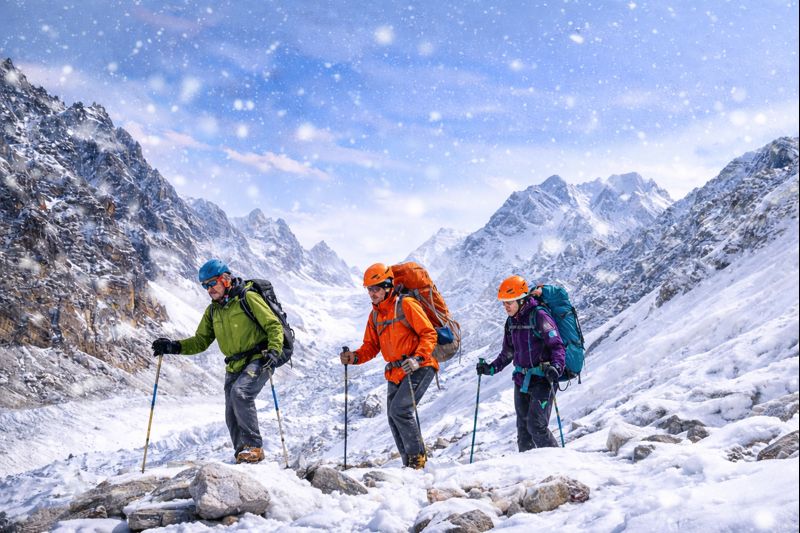
Prepare for Himalayan Winter Treks : 9 Prerequisites
Winter trekking in India attracts all the adventure junkies to the Himalaya. No longer the Monsoon settles its leg than the trekkers initiate their plan to escape their hectic life. What attracts these folks is the sheer cold weather! Winter treks in December are one of the coldest ones. The mere fun to finally utilize the jackets that we had invested our hard-earned money has arisen. It is simply mesmerising to be on one of the winter treks in Uttarakhand and Himachal. However, there are important prerequisites to be considered before you start this vacation of your life.
How to prepare for the winter treks? It is very similar to summer treks but the only difference is that it needs additional gear to protect us from harsh cold weather. Let us discuss the 9 pre-requisites to Winter trekking.
1. Winter Clothing
While you tremble your nerves and stand contracted to hold a cup of hot tea in your hands, you are all covered in warm clothing from top to bottom. This is the general shape of everyone who has opted for an exciting winter trek. Your focus is on how to be warm. The weather is indeed harsh. While you trek you will not realise the coldness owing to the exertion. The body heat warms you through the way. It is when you arrive at the campsites and the body cools down, the thorny winter is on its way to give you shivers down the spine.
Different treks require different layers of clothing. For example, if you opt for Chadar Trek or Kedarkantha Trek, you definitely need one down jacket, two fleeces, and thermals. While you opt for low-altitude frozen lake treks, Nag Tibba Trek, Hampta Pass Trek, or say Parashar lake trek, you can cut down to one fleece. This also depends on how much cold one can bear.
Apart from these, woolen gloves and socks, bandana, balaclava or a monkey muffler are indispensable to cover your hands, feet, face, and neck, respectively. Considering the winter treks, the base layer of the t-shirt should be full sleeves and made up of a wicking fabric while the trek pants should be quick-dry one.
Sunglasses are extremely important for the winter trek. They will protect the eyes from the intense reflection of light from the snow.
2. Trek Gear
Winter hiking gear includes a little bit more of material than a summer Himalayan trek. Gaiters will avoid the entry of snow into your snow trekking shoes. The shoes should be waterproof or resistant. Stepping through the snow will eventually wet your feet. Therefore, gaiters and proper trekking shoes are mandatory. A trekking pole is like a third leg. The pole not only lends ease in hiking up in snow but also assists in guiding the route.
3. Physical Exercises
Working out is an important prerequisite for any Himalayan treks irrespective of it being a summer or winter one. While workouts you are training your body to be well-ready for imposing the strenuous climb you will undertake at your trek.
Your feet are largely used while you trek and hence strengthening your lower body is essential. For the same, as a starter for someone who is a novice to the whole thing, running is the first step. The more you run the better your legs will be toned and capable. There are many Youtube videos available that can guide you to strengthen your legs. Moreover, you will carry your rucksacks, so it will be a cooler idea to practice climbing stairs with your dummy rucksack, a month prior. Clubbing the runs with planks, lunges, and stretching will recover the muscles.
4. Treading Snow Trails
It is very tricky to walk on the snowy trail. If the course is formed it will not be that an issue. However, the fresh snow layers will give you a very complicated time. Hence realizing the depth of the snow before taking the next step by using the trekking pole will help. Snow trekking shoes will also help to hike up easily.
While ascending a snow-covered slope, for beginners you can walk like a duck. Step on your side soles, using the edge of shoes. This helps in having a stronger grip. Using your trekking pole for better support. At the same time, during the descent, climb down on your heels. If you hike down on flat sole, there is a chance of slipping and hurting oneself.
5. Keeping Hydrated
Keeping your body hydrated is extremely indispensable while on winter treks in December. The cold weather might provide you with moisture but the exertion caused by consistent climbing does dry you up. Apart from regularly sipping water at intervals, also do not skip the tea served to you during the treks. Soups or any form of juice should be regularly consumed. A hydrated body will help in sustaining the normal metabolism.
Besides, consuming local water is key to acclimatization.
6. Pre-Trek Preparation Regarding Food
The nutrition is the fundamental feature not only during the trek but also before you start. Consume carbohydrate-rich food like whole-wheat products. You will surpass altitude and thus the capacity to breathe in the oxygen should be well balanced to avoid high altitude sickness. Iron-rich food like beetroot, carrot, green leafy vegetables will induce the essential core strength.
7. Toiletries
Sunscreen, moisturizer, sanitizer, tissue rolls, wet wipes, lip balm, talcum powder, doctor tape forms a common list of toiletries while you go for a winter trek in the Himalayas. Chapped lips if remain untreated could bleed. It is, therefore, essential to moisturize your face and especially uncovered areas of the body.
Use talcum powder that resists fungal infection on your toes before wearing the socks. This will protect your feet.
8. Basic guidelines
Acclimatize well. The only key to being fresh, hale and hearty during the complete trek is to appropriately acclimatize. Move around your base camp for a day, undertake some adventure activities like rock climbing or rappelling to suit yourself to the climate there.
Do not leave the group. Trying to explore alone in newer regions is not only harmful to yourself but also jeopardizes the stability of the fellowmen.
Following a basic common sense while you trek is advisable. Being responsible for the cleanliness of the Himalayas, keep a garbage bag with yourself to avoid littering at camps. The same bag could be discarded once you return to the base.
Avoiding being in excessive contact with the snow. Wear gloves all the time. Touching the snow often might later give burns to your hands.
While you sleep, keep your phone and camera batteries inside your sleeping bag to avoid untimely drain.
9. Enjoying The Moments
These are moments to be cherished as they don’t revisit. Amidst the hectic schedule of city life, spending a vacation in this pristine environment will rejuvenate your conscience. The refreshed mind is ready to deal with the day to day life’s routine. Ignore the phone and bask in the beauty of nature.
Har ki Dun Trek | Bali Pass trek | Phulara Ridge Trek | Dayara Bugyal Trek | Gidara Bugyal trek | Gaumukh Tapovan trek | Valley of Flowers trek | Chopta Chandrashila Trek | Brahmatal Trek | 18 Treks from Sankri Base Camp | Kashmir Great Lakes Trek |
About Author

Urvi Chheda
Urvi Chheda is an avid trekker and has completed her mountaineering courses. Fiddles in photography, sketching, reading, watching movies and practising Improv. She recently finished Basic Skiing Course from IISM, Gulmarg.
Recent news

06 Jan 2026

03 Jan 2026


